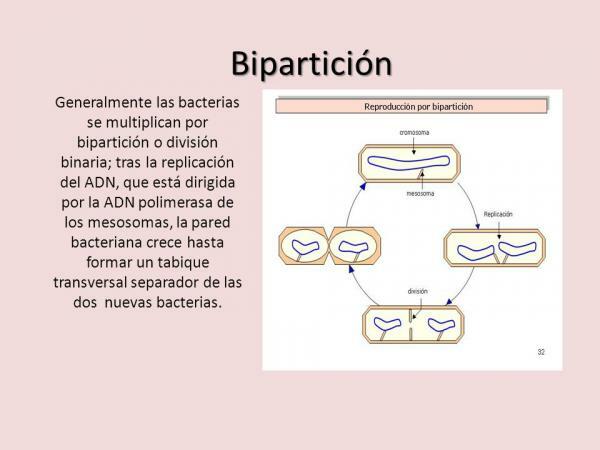Bipartition: definition and examples

Image: Slideshare
One of the main functions that living beings carry out is reproduction, which is vital for the survival of the species. The reproduction can be of different kinds, being able to be sexual or asexual, the first being in which two parents participate and the second in which only one parent participates. To learn about one of the most common types of asexual reproduction, in this lesson from a TEACHER we are going to talk about bipartition: definition and examples.
To understand what bipartition is, we must first talk about the asexual reproduction, to understand how it differs from the sexual one since bipartition is a type of this kind of reproduction.
Asexual reproduction is a type of reproduction of some living beings in which the cells of a living being undergo a mitosis process and from them another living being is born. This type of reproduction is characterized in that it only needs one parent, unlike beings that reproduce sexually, which need two parents and sex cells.
It should be taken into account that not all cases of asexual reproduction are the same, there are many types of different reproduction, depending on large factors such as the number of cells or the type of being alive. Some types of asexual reproduction are bipartition, gemmation or fragmentation.

Image: Comparative Charts
Bipartition or binary fission is a type of asexual reproduction in which one being becomes two new beings equal. It is based on a process in which the genetic code of an organism is divided in two.
This type of reproduction is characteristic of bacteria and archaea, beings that have a great ability to divide, especially in favorable environments. For this reason, the population of bacteria can grow rapidly, creating a huge number of beings in a few minutes, and can grow much faster if conditions are good.
Bipartition process
The bipartition occurs by a short process, which ends when the cell has been fully duplicated. The parts of which this process consists are the following.
- Concentration: All the genetic information in the cell is concentrated in one place, a single chromosome which has all the information. It is on that chromosome where the bipartition process begins.
- Replication: This is considered as the initiation phase of the bipartition procedure. From the single chromosome begins a process of replicating chromosomes, creating two equal origins that seeks to separate and escape from the chromosome from which they were born. The two each move to one end of the chromosome, and two different chromosomes end up appearing when the chromosome is broken.
- Division: The two chromosomes move away from each other inside the cell, causing it to get an elongated shape. When the two chromosomes reach the ends, a cell wall is created between them.
- Cytokinesis: To conclude the process, the wall divides in two, the cells are separated and with it two new living beings emerge.

Image: Slideplayer
To conclude this definition lesson and examples of bipartition we must talk about the different types of bipartition, depending on the way in which the cell from which the new being is born divides. The bipartition can be of the following types:
- Regular or simple: It happens when the cell divides symmetrically, dividing into two equal parts. An example would be amoebas.
- Longitudinal: cell division follows a longitudinal axis. An example are the flagellated.
- Cross: cell division follows the transverse axis. An example are the paramecia.
- Oblique: the division is halfway between the longitudinal and the transversal. An example are the opaline.
- Multiple: This happens when the cell does not divide into two, but divides into a larger number, forming more cells instead of just two. Bacteria that divide in this way reproduce much faster, being much more dangerous if they are bad for humans, such as some diseases.
- Irregular: cell division does not have a common pattern, being the least common type of bipartition.


